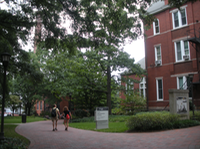Creating a Realistic College List! by Patti Brugman
So often students make a college list that is full of random schools that they’ve heard of, schools that might impress friends, or that have a football team. How do you find schools that are right for you? College should be a place that offers you a personal connection. While there may not be a “perfect fit” college for everyone, there should certainly be a “pretty good fit.” Creating a list of great schools can be great fun. Make it long and diverse, then shorten it to about 10 schools. Look for schools that excite your intellectual curiosity and offer great programs that lead to your success. How exciting is that!
Here a few ways to help you create a real college list, one full of schools that are just right for you:
1. Start with your stats: There is no sense applying to Pomona College if you’re a happy B+ student. Start your search by writing out your GPA, the AP classes you’ve taken, and any honors you’ve received. Add in the best scores from your ACT or SAT tests. The stronger your service and leadership, the more reach schools you can consider.
Rubric for the best College Application Essays:
1. Open with a snappy sentence. Admissions counselors read hundreds of essays this time of year. Make yours stand out from the first sentence. Then, carry that energy through to the bottom. When you proof read, eliminate any bits that go off topic or might allow the reader to doze!
2. Show your good character. Write like you’re trying to tell a good story. After you write your essay, proof read for any negative words. Turn your weaknesses into strengths. Admissions counselors would love to know that they are admitting students who have good values, are honest, hardworking, and eager to help others.
3. Show your passions. If there is something in your life that drives you to excel, talk about it. If you have a hobby, talk about it. If there is something in society that angers you to want to change the world, tell the story. Admissions counselors are looking for students who care because those are the students who will use their college education to make our world better.
4. Use specific examples full of colorful detail. Admissions counselors love to see your world. Show a scene from your garage, your dinner table, or a moment on the trail where you run every day. These examples are often what sway Admissions Counselor in your favor. If you show them your world, they feel that they know you.
Asking for Recommendations
George Washington University

Think of your college application as a bit of a backstage construction for what you want your theater audience to see. The Admissions officers are your audience. When you submit, you are on stage.
Frightening? Not really because your audience is friendly and you know your part. You are presenting exactly who you are through grades, the classes you have taken, and your scores. Your fabulous essay is your stage monologue, which is creative, real, and a reflection of who you are. The only thing that could be a conundrum is your teacher recommendations.
With a bit of planning, these letters can be your “rave reviews.” Colleges request that you ask for one each from a math or science teacher and an English or history teacher. Your applicant schools want to see that you are a responsible and respected student in your core subject areas. Now is when you must plan carefully. School is well underway, the workload is piling up, and many, many students are asking the same teachers for recommendations.
Setting Your Course to College! by Patti Brugman
Just a few days ago, (July 2013) my brother left aboard Medicine Man on his 8th Transpacific Yacht Race to Hawaii. The secret to winning, he says, is to strengthen yourself, your crew, and your ship. In addition, you’ve got to play the winds and set the best course to the finish line. I liken my brother’s formula to the whole college process. And most important, we both agree, is building yourself for the finish.
If you’re beginning the college process or just thinking about it, let’s consider how to strengthen yourself, so that your teachers and school can help you set a winning course to the right college. First, let’s find your personal areas of strength. Some students might think they have only have a few of the following talents, but if you look at the list carefully, you might find that you can bolster your appeal by developing strengths in other areas. Here the ones that I think are most important for academic success and college acceptances:
· Academic Strength: The most important information you send to colleges is your transcript. (Your essays are second, followed by recommendations and test scores.) To improve your standing, increase your intellectual curiosity. The more you want to know something, the better you’ll do in the subject. Read, visit museums, and talk to smart people to find areas that you want to know more about. Then take action. Now is the time!
Why Study in the South? by Patti Brugman
Georgia Tech

Emory University

Greetings from Atlanta, Georgia where a California student can find warmth, both in temperature and in spirit! For the excellent student looking for academic inspiration and chances for big merit scholarships, check out the South. For the student who wants a campus with a sports program so big that the fans drive in from neighboring states, come to the South. For the student who wants to focus on who they are in the world on a single sex campus, try the South.
After talking with students and faculty, these are my impressions of five outstanding campuses:
Georgia Institute of Technology: Georgia Tech, home of the yellow jackets, is a green spot in the city. Everything is within walking distance and yet, the campus is quiet and secluded. It’s the best of both worlds. For science, technology, engineering, and architecture majors, it claims to be in the top five. Dr. Marilyn Wolf, from computer science, says she accepted an offer here after teaching at Princeton for 18 years because of the quality of the students and the freedom to do the kind of research she wanted.
Why Attend a Large Research University?
These days, we hear a lot about the importance of class size and the benefits of teacher-student ratios on campus. If there is such an advantage, why would anyone choose to attend a large university?
People talk about the 300 student lecture halls at the University of California and what it’s like to sneak in late and sit in the back of the class, or sleep in late and never get to class! Stephen Pastis, the comic writer of “Pearls Before Swine,” says, “When I was at the University of California at Berkeley, I went to some classes that must have had more than four hundred students in them. I almost always sat in the far back of the auditorium so I could read the newspaper. I remember that I stayed late one day to ask the professor a question, and when I got up to him, all I could think to myself was, 'So this is what the professor looks like.’”
I laugh every time I read that quote. It illustrates the point so nicely. In recent years, however, I have become a big believer in the large university for some students. One particular student, Heather, had a perfect high school record with a transcript full of AP classes. She had stellar ACT scores, outstanding community service and leadership and her pick of almost any school in the nation.
Getting a “Full Ride” for Four Years by Patti Brugman
This year we had more than one family with severe money concerns. These families each wanted their students to receive merit money or even win a “full ride” for four years. Though there is no easy money out there, starting early, working hard, and lowering your expectations are great ways to save on tuition. I'd like to share a few financial case studies on the money problems and solutions that some of our families have faced in recent years (while also protecting the privacy of our clients.)
Here are a few Case Studies that illustrate a range of money struggles and solutions:
1. A talented student from a financially stable family: Michelle’s dad saved for years and budgeted for $40k per year for college. Michelle is a very gifted student and was accepted to all of her reach schools. Her first choice was Georgetown, but as with most top tier schools, Georgetown does not offer merit money. The family doesn’t qualify for financial aid so if Michelle attends Georgetown, the family will be expected to pay $60k per year. Because of the deal with her dad, Michelle would need to borrow $20k per year in order to attend. Michelle was also accepted to Occidental College where she was granted $15k per year in merit money. Her dad was delighted with this award and offered to pay the remaining $45k per year (even though it was over budget.) Michelle declined Georgetown in favor of her best target school, Occidental College. Once enrolled, she earned the recognition of her biology professor and was offered a lucrative summer internship, which allowed her to save for medical school.
Case Studies From The Class of 2013
May 1st was the deadline for students to choose their future colleges from the list of schools that accepted them. Through their own successes and mistakes, our students have a lot to teach next year’s applicants. Now, as future seniors and their families begin to worry about finances and college choices, it’s a good time to learn from others.
Here are four Case Studies from our students from the class of 2013 (all names have been changed and the stories disguised for the sake of student privacy):
· Paul came to us early with great enthusiasm, a 3.7, strong SATs and some financial considerations. We noticed right away that he didn’t have a history of strong community service, but that his leadership in school clubs had been very strong. We helped him bolster his leadership and reflect on a few difficulties in his family life. He ended up writing a terrific essay about an encounter with his estranged father, a story that made us both cry and laugh. Paul was accepted to Willamette, Boston College, Lewis and Clark, and LMU. He will be attending Lewis and Clark College (Oregon) with financial aid that includes 70% grants and 30% loans. We think money made a huge difference in his final college decision, but so did the campus. He had a chance to visit and loved the small classes and the proximity to Portland. “Best of all,” he says, “at Lewis and Clark you can see nature out of every window on campus!”
Now That You're In, What Should You Do?
Now that you’re in and have accepted your best school, there’s just a little more to do. Besides finishing the year with good grades, follow these guidelines and you’ll be in the best shape for your new school:
1. Contact the schools that you’ve declined and let them know that you won’t be coming. This will open up a space for a student on the Wait List.
If you’ve been wait listed anywhere, you’ll hope that other people are following this same courtesy so that your name can float to the top of the list!
2. Sign up for housing, a meal plan, and financial aid. Wait too long, and you might be homeless or off-campus. Most students are not left homeless, but by signing up early, you will have more to choose from. Read up on your choices before making your choice.
3. Let your school counselor know where you’re attending. He or she will send your transcripts and update school records. School counselors are more than statistics mongers. They love to celebrate their students’ successes. Go on in and make his/her day!
Financing Your College Future! by Patti Brugman
With college acceptances fanned out like travel brochures, students now need to accept just one school by May 1st. Offers of financial aid are often a deciding factor for both the student and the family. Students who have applied wisely, should have at least one affordable choice. A good selection of college options should include schools that ask you to pay: 1) the full price, 2) the full price less merit scholarships, or 3) much less with financial aid. Let’s talk about each of these.
· Full Pay: Students who apply to highly competitive schools will not be offered any kind of merit aid. The philosophy at Wellesley College and other high-end schools is that all accepted students deserve merit aid, so none is offered. At these schools, families are expected to pay the full price of education or qualify for financial aid. If they qualify for financial aid, their needs will be fully met.
· Merit Scholarships: Students who offer a lot of passion, talent and diversity, despite their financial situation, may be offered a merit scholarship to entice them to accept a second choice school. These can be very attractive offers to families who might not qualify for financial aid, but still feel that the full cost of education is too high. Remember that for a student who is full of potential, a great education can be found at any school. Why not accept the one that offers a generous merit scholarship?
Now that You’re In! by Patti Brugman
Now that you’re in and have accepted your best school, there’s more to do. Follow these guidelines and you’ll be in the best shape for your new school:
1. Contact the schools that you’ve declined and let them know that you won’t be coming. This will open up a space for a student on the Wait List.
2. Sign up for housing, a meal plan, and financial aid.
3. Let your school counselor know where you’re attending. They will send your transcripts and update their records.
4. If you took any college level courses at a junior college or online through a college, be sure that those transcripts are sent to your college.
5. After you take AP tests this week and next, and receive your scores, make sure they are sent to your new school for credit.
6. Send thank you notes to those who wrote your letters of recommendation or helped you in any way with your admission. Not only is the polite thing to do, but those contacts may serve you again someday. Keep them strong.
7. Update your FAFSA application.
May Day is Decision Day! by Patti Brugman
After years of planning, May 1st is Decision Day for high school students hoping to attend college in the fall. Let me give you a checklist so that this most important decision is done as well as the rest of your work!
· Send in Your Deposit for the right amount, to the right school, on time, and for all the right reasons.
· Review Your List one more time. Make a spreadsheet, a list, or just talk it over once more before making the commitment. Knowing your priorities is essential for a no-regrets decision.
· Value vs. Price Tag is sometimes hard to figure. There are many ways to assess the value of your school—quality of professors, program, internships, chances for employment, distance from home, and connections. Make sure that your school choice will allow you to graduate in 4 years. Any longer, and the price goes up!
· The Wait List may still hold your favorite school. Go ahead and deposit at your second choice. Devote your emotional energy to that school. If you hear from your WL school, you’ll have a chance to reconsider then. Relax, pay, and be confident in your decision.
What it Means to be Wait Listed by Patti Brugman
If you have recently opened a slew of envelopes from the schools you applied to and found that they weren’t all “Yes! We’d love for you attend!” you might be feeling some honest disappointment. We have noticed that even when students are accepted to their first choice school, but are Wait Listed at their second choice school, there is a feeling of sadness.
Please don’t take this personally. If you have worked with us, we assure you, each school took extra time with your application because it was done in your best voice. We made sure of that. If you want to pursue a school where you were denied admission, call us. We’ll see what we can do. But, if you were Wait Listed and absolutely want to attend that school, there is a lot to be done!
The Wait List is a school’s chance to admit a full freshman class for the 2011 school year. Admissions people do a lot of guessing about numbers. They don’t want to accept too many and they don’t want to accept too few. They want to get it just right. The Wait List is the tool to let them do their job and your chance to decide if you really want to attend University A or College B. Which is truly right for you? You were accepted at one, but Wait Listed at the other.
Motivating the Reluctant Junior by Patti Brugman
Just the other day, one of our clients was recounting his high school experience thus far. He said, “I’ve been working my tail off so that I can get into a great college and then work even harder!" Laughter burst from him as caught the irony of his words. "Please explain the logic of this to me.”
This student, who is actually a hard-working, college-bound, young man, brings up an interesting point. Junior year is the time to assess a student’s readiness for college. While we’d like to see the perfect fit for every high school student, sometimes the perfect fit is not college. Making that decision means coming up with an alternative choice for employment or service right out of high school. (Also, see our Blog on “The Gap Year.”)
No one likes to throw money away and college is a big expense. But let’s not jump ship yet. The “maybe” student might actually be a “yes” student if we ask the right questions. Before we begin the college process, we’d love to know that the student has a passion for something that the college experience will provide. Sometimes, we meet with students who are a little tired of the whole thing. If the student seems unmotivated, our question to him/her is, “What do you think you need to know in order to live a satisfying life?”
Making the Right College Decision by Patti Brugman
Whether you are the proud recipient of a fistful of college acceptances, or right at the beginning of the college process, you have decisions to make. Which school from my list or from the thick college selection book is right for me?
Students who work hard and have ambitions, have a right to want to attend not only a good school, but the right school. When we work with students, we talk to them about their priorities, even as the student is just beginning to discover them. Is the cost of college a huge consideration? Is location a factor? Weather? Program? Do you think the strength of the academic program is as important as the strength of the football program? School spirit plays a huge part in some student’s feelings for college, while other students are much more concerned about personalized learning.
Choosing the right school starts with knowing yourself, your learning style, your motivations, and your limitations. Once you know what you love to learn, you’re ready to search. Conversely, knowing what distracts you is also essential for choosing the right school from the thousands of choices.
Taking A Gap Year by Joyce Salter
The infamous Gap Year –it worked for Prince William and Prince Harry, but will it work for me? That’s a question best answered by your circumstances. Let’s say you didn’t get into any of your top schools – after all, 2011 has been the hardest year ever for admissions – and you want to up your “irresistibility factor” so that you can apply again next year. Now is the time to make that year count – which in no way resembles “taking a breather on the couch.”
It may be a time to consider deeply what you really want from college, or dare we say it, life? Since college is a huge investment of both time and money, sometimes a year off is just what is needed to put your education goals in perspective. Your extra year of maturity and self-reflection will serve you well when you become a freshman the following year.
The Gap Year is your perfect opportunity to find a career-related job, internship or volunteer work. It’s your chance to study up to re-take your SAT or GRE test, while you supplement your extra credit by taking related classes at your city college. If you’re creative, it’s a golden window for writing that play or novel, expanding your art portfolio, or practicing for that cello audition. Look upon the year as a chance to enhance your potential and increase your self-confidence. When application season rolls around again, you’ll be ready to meet it head-on. –JS
Acceptances and the Family Finances by Patti Brugman
When we’re at the beginning of the college admissions process, imaginations run wild. It is great fun thinking of all the places you could go to college. You might consider Washington D.C., Ohio, the deep South or Oregon. The world is your apple!
Gradually, with your objectives in mind, the list shrinks. Finally, you and your family look closely and hone your final list to perfection. Then you apply and wait.
Tick, tock. The envelopes start arriving. Yes! No. Wait list, wait list. Yes, with money. Yes, with lots of money! How do you decide?
In fact, there is quite a bit to consider here. While we hope you have visited your schools by now, now may be the most important time to take a look at your choices again before deciding. Buy those plane tickets, quick!
And while you’re visiting campuses, visit the Financial Aid Office at each. You might be able to up your offer while on campus. (This is also a good way to move up on the Wait List—see our blog.) If you’ve received an offer of financial aid and like the school, consider it carefully. Money often makes a big difference to families. You’re not alone there. For some students, the most affordable school is the best school because you will have the greatest chance of actually graduating.
The Swirl Student by Joyce Salter
There is a growing epidemic among college freshman – a sense of dissatisfaction with their college choice and an overwhelming homesickness, that is causing more students than ever to jump ship and go home. Whether they tough it out for a year, a semester, or even a few weeks, the end result is that these students find themselves awash on the shores of home – alienated from their friends who are still in college and too “grown-up” to enjoy living with mom and dad again. Because their choices leave them feeling adrift, this group has been called “swirl students.”
The swirl student believes that any option is better than their current one when they’re faced with the typical challenges of freshman year. They have trouble fitting in with the student body, they miss their friends back home and sometimes they just hate the weather. They believe that they’ll have many better options when they get home – i.e. a simple transfer to another college, or a gap year at a city college while they decide on their next move. The problem with this reasoning is that they are not the only students with this game plan. City colleges are overwhelmed with students just like them, and their budget cuts have made them more selective than ever. Many of them find that transferring to other 4-year colleges is more difficult than ever, and are forced to take a year off while they wait for the next admission deadline to roll around. They find themselves wasting valuable time until their new options open up.
The College Trip by Patti Brugman
I recently returned from a college trip in Oregon and cannot stress how important it is to see before you buy. The colleges I set out to see were: Oregon State University, Lewis and Clark, and Reed College. How different these three are!
OSU is a state school whose motto is “Powered by Orange.” It’s a great place to learn forestry or engineering and to go to the “game.” I talked to one student who thought he was quite rebellious for choosing to be an English major at OSU rather than transferring to The University of Oregon in Eugene where the major is more the norm. Then he confessed that he was actually a double major in ECE, electrical computer engineering.
At OSU, the MU is the center of campus. The Memorial Union is a gorgeous old brick building with a hall of international flags, many restaurants, the bookstore, a ballroom, and a bowling alley. All over campus, old architecture blends with the new. Students love showing off the Kelly Engineering building and the mobiles are designed to circulate the rising hot air to colder parts of the building. It is truly inspirational.
What Are Colleges Looking For? by Patti Brugman
We were just at the St. Francis College Fair last night (as listed on our calendar a few weeks ago) where I had a chance to talk to several students. The question seemed to be whether or not they should apply to reach colleges like USC or Columbia or smaller colleges like Lafayette, Gettysburg, or Kenyon. One girl asked, “If I apply to a school like Cornell College, do you think I’ll be accepted?”
All colleges are looking for certain qualities in a student body. Truthfully, the admissions representatives that I met last night would be delighted if every student there would send them an application. They are that excited about this population of kids. Isn’t that great news?
Below, are some of the important criteria that college reps told me they are looking for in their applicants. Communicate these points in your essay and your interview (optional) and you’ll be in great shape.
1. Can you do the work? Colleges universally want to know that students who come to their school can work to the institution’s expected level. This is what your transcript and scores communicate so add colleges to your list that are within the expected range.
This is a new weblog. You can replace this text with an introduction to your blog, or just delete it if you wish. To add an entry to the weblog, add a new page using the “Pages” button in the toolbar. For more information on blogging with Sandvox, please have a look through our help guide.



